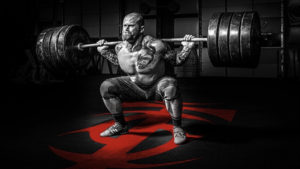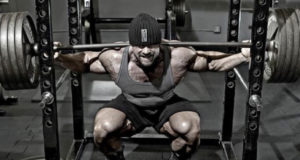Activation of back and lower limb muscles during squat exercises with different trunk flexion
[Purpose] The purpose of this study was to investigate the activation of back and lower limb muscles in subjects who were performing a squat exercise at different angles of trunk flexion. [Subjects and Methods] Twenty healthy subjects (age 21.1± 1.8 years, height 168.7 ± 8.2 cm, weight 66.1 ± 12.3 kg) volunteered. The activation of the erector spinae muscle, rectus femoris muscle, gluteus maximus muscle and biceps femoris muscle was observed while the subjects performed squat exercises with a trunk flexion of 0°, 15°, and 30°. [Results] The erector spinae muscle, gluteus maximus muscle, and biceps femoris muscle were activated more during the squat exercise with the trunk flexion at 30° than the exercise with the trunk flexion at 0°. The rectus femoris muscle showed a tendency to decrease as the truck flexion increased. [Conclusion] Squat exercise be executed while maintaining an erect trunk posture if one wishes to strengthen the quadriceps muscle while reducing the load on the lower back.
CORE Physical Therapy In Omaha Explains..
By Dr. Mark Rathjen PT DPT CSCS
Omaha Nebraska
The conclusion of the article clearly states “Squat exercise be executed while maintaining an erect trunk posture if one wishes to strengthen the quadriceps muscle while reducing the load on the lower back.” As the body stays more erect, the emphasis is going to fall on the quads. (front squats, high bar squats, safety squat bar squats). When the trunk starts to incline at a higher rate ( lower bar squats, wider stances Etc) the body switches to more glutei and hams. This will lead to a higher utilization of the lumbar para-spinal muscles as well.
We see this very principle with trap bar deadlifting vs conventional deadlifting. As the weight moves away from the lifters center of mass (conventional deadlifting) the hams and back increase activation. As the weight moves toward the lifters center of mass (sumo deadlifting and trap deadlifting) the body will focus on quads and more balanced lower body recruitment. This principle also allows our lifters to continue lifting and activation while switching some of the emphasis away from and injured area while they are being treated for the injury. We can also use this to address asymmetries and weaknesses.
With the knowledge and expertise we provide at CORE Physical Therapy in Omaha, we work around your injuries while simultaneously healing the issues that bring you in to our office. We rarely suggest stopping all activities. That would have many other issues that would follow that. We suggest a plan that works toward your goals, around your injuries as they heal and towards a preventative program moving forward. We work with you. We work with your injuries. We work with your goals. We get you better. We do it fast. We do it right.
C.O.R.E. Physical Therapy and Sports Performance PC,
17660 Wright St, Suites 9/10
Omaha, NE 68130
402-930-4027
At CORE Physical Therapy in Omaha, We specialize in the treatment of athletes. We have worked with athletes for a combined 30 years.
This is who are, This is what we do.
Owned and Operated
by
Dr. Mark Rathjen and Dr. Claire Rathjen.
CORE is a family owned business
est. 2015
We are proud to serve the greater Omaha metro area.
For More information, Please feel free to contact us https://coreomaha.com/contact/
Please feel free to follow us at https://www.facebook.com/COREomaha/
To get started https://coreomaha.com/getting-started/
For more Blog information https://coreomaha.com/blog/
Youtube Account linked below.
https://www.youtube.com/channel/UCVg8OSN5h-i1n_ykw1Gvahg?view_as=subscriber


